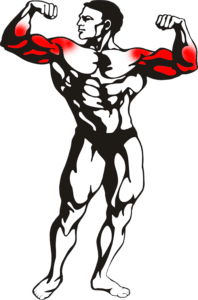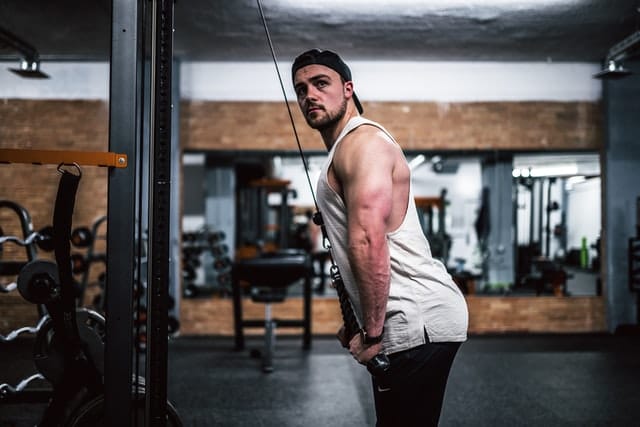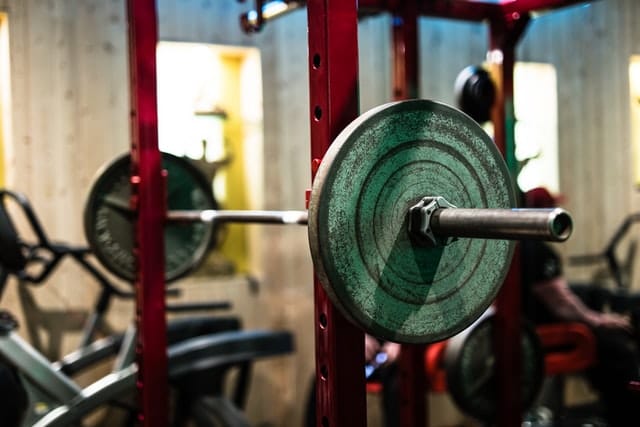You probably know that warming up before a weight training session is essential , especially to preserve your joints or avoid injury. Even if most athletes know it (if not all), we see that this step is rarely taken seriously by practitioners, it is rather seen as a waste of time …
Indeed, warming up is not fun, it takes a long time and what more is it in the end? You might as well do it quickly to clear your conscience!
Big mistake. The warm-up not only contributes to your longevity in practice, but also to your progress. Knowing how to warm up will even make a big difference, especially in your performance, which ultimately results in muscle gain.
Let’s see what the benefits are first before we get into practice.
Summary:
The benefits of a good warm-up before a weight training session

At first glance, the warm-up may seem superfluous. Some practitioners therefore perform a few light sets to warm up, gradually increasing the load on the exercise in question.
Indeed, if it is done randomly, it is difficult to reap immediate benefits to improve its performance.
In fact, just like a program, the strength training warm-up must be adapted not only according to the planned training, but also according to the environment and the profile of the practitioner.
For example, it’s difficult to perform the same when you wake up as in the middle of the afternoon or in winter rather than summer. Likewise, the athlete’s age, experience and diet are essential factors in giving even more importance to this preparation before exercise.
The goal is to raise the temperature in order to make the tendons and muscles less rigid, to prepare the nervous and cardiovascular system for the effort and to increase the production of synovial fluid to limit friction between the joints.
In short, warming up before your weight training session deserves to be taken seriously for several reasons:
- Being stronger (improving the transmission of nerve impulses)
- Preventing injuries and other pathologies
- Improving motor coordination
Raise the body temperature before specific warm-ups to prepare for the effort
To begin with, it is essential to gradually increase your body temperature before moving on to specific warm-ups.
This step is essential in order to limit excessive temperature differences between the different muscles and tissues (the tendons and the ends of the muscle are colder than in the center), but also to increase your heart rate / respiratory rate to provide the necessary oxygen during exercise.
For that, you don’t have to do excessively energy-intensive exercises like running or other cardio exercises. This could be walking, low-intensity rowing, or a long series resistance exercise like pelvic rotations for abs or chest raises for lower back. You can therefore take advantage of this moment to work on a weak point, which is beneficial for motor learning.
The warm-up time will depend on the ambient temperature, the time of day and your current diet. No need to spend a lot of time. Too much temperature rise, leading to overheating, is on the contrary counterproductive. It takes about 5 minutes for this to be sufficient.

Specific heating of muscles, tendons and joints
After having spent a few minutes on the mat, the rower or the Roman chair, it is time to perform movements allowing to warm up the risk areas , fragile and very stressed during your strength training.
The warm-up time will vary depending on your routine. For example, for a pectorals / biceps session it will be shorter than for a full body workout, because the number of muscles and joints involved will be higher.
The places most vulnerable to wear pathologies, such as tendonitis, are as follows:
- Shoulders / Rotator cuff
- Biceps (long head tendon)
- Knees
- Elbows
- Wrists
The choice of exercises according to your morphology, the quality of recovery and the warm-up makes it possible to limit or even inhibit the risk of wear pathologies. Very disabling, it forces you to be patient until it recovers.
Regarding “immediate” injuries, the most frequent in bodybuilding are muscle tears and / or tendon ruptures in the biceps, triceps and pectorals. Lack of warm-up, cool-down, handling a high workload, and over-stretching the muscle significantly increase these risks. Note that this type of injury not only handicaps from a mechanical point of view, but also aesthetically. Unfortunately, even after an operation, it is difficult if not impossible to realize its full potential.
Warm-up exercises for the upper body

Here is an example of a warm-up for an upper body session . Exercises should be done with light loads in order to save yourself afterwards.
This routine requires very little weight training equipment, a pair of dumbbells weighing a few pounds and ideally a pulley is more than enough to easily perform without rest. This circuit should be done once (or two depending on the situation), with around thirty repetitions for each exercise:
Shoulders and rotator cuff
Frontal elevations are also useful for warming up the tendon of the long head of the biceps .
- Lateral elevation, frontal elevation and bent bust
- L-fly (preferably pulley or lying down with a dumbbell)
Arms: biceps, triceps and forearms
Do not hesitate to vary the curls in order to warm up the brachioradialis (supination, neutral and pronation)
- bicep curl
- Vertical tricep extension
- Wrist curl / extension
Movements to warm up the lower body
Regarding the lower body, the procedure remains the same. Do not hesitate to do more sets and repetitions for the thighs. This is because the muscles in the leg are much bigger, so it takes longer to warm up the entire thigh.
Thighs and buttocks
You can play with the spacing of the legs in order to properly warm up all the thighs , especially the adductors. Special attention should be paid to hamstrings.
- Squat
- Straight Leg Deadlift
- Lateral Leg Raise
Calves
Short calves tend to lose heat more quickly. If this is your case, avoid training in shorts if it is cold.
- Extension of the standing calves
Lumbar
The lumbar muscles are constantly used on the basic movements for the thighs.
Preparing the nervous system before training to improve muscle sensations and gain strength

This phase is particularly useful for the sequel in order to get closer to your maximum performance and / or to better feel the target muscles during training , this is not is therefore not essential. These techniques should be used sparingly, preferably for your weak spots, to avoid lengthy sessions.
For this, the isolation exercises and potentiation will be relatively effective in order to prepare properly in a minimum of time.
Warm up with isolation exercises to improve muscle feeling

For warming up, isolation exercises can be useful to improve the feel of the target muscle while performing a polyarticular exercise, which could be similar to the prefatigue.
The advantage, compared to pre-fatigue, is to benefit from this positive transfer (solicitation of the desired muscle) on large movements, without hampering your strength. You can do the test on a heavy session, for example, if you have trouble feeling the triceps on dips, you can include a few sets on the pulley as a warm-up (pushdown …) before you start.
This way of doing things was really useful to better recruit my pectorals on heavy sessions, consisting of basic exercises, with movements performed in explosives, even if initially it was a weak point. On the other hand, for the workouts where I prioritize the congestion, with light loads, I will rather use the pre / postfatigue in order to lengthen the time under tension, but also to maintain the burning sensation as long as possible, which results from it. increased metabolic stress.
Let’s move on to execution. Be sure to stop well before failure to conserve strength and energy for the session. Likewise, you absolutely must handle light loads to concentrate as much as possible on the contraction of the muscle. Also, don’t hesitate to slow down the movement if you have no sensation.
You can do 1 to 2 sets of about 30 reps on any exercise, such as pulley spreads for the pecs or leg extensions for the quadriceps, as long as it is ‘acts of isolation.
Prepare your nervous system using potentiation in order to be stronger in training

Haven’t you noticed that some days the bars feel heavier? The solution to avoid this: potentiator exercises. They can be done before a weight training session to prepare the nervous system for heavy lifting .
As a reminder, the role of the SN is to give and receive information, so it is it that gives the order to the muscles to contract. The more effective it is, the faster it can activate a large number of muscle fibers. Theoretically, the more powerful this nervous “discharge”, the stronger you will be.
The idea is therefore to send big nerve shocks on the potentiator exercises in order to better understand your workloads afterwards. So you can use the potentiation for your sessions requiring a lot of strength.
The movement must be explosive and carried out over small amplitudes to use your involuntary strength to the maximum, thanks to the myotatic reflex.
For my part, I like to do a few sets of very heavy shrugs before my chest and back sessions. For my leg sessions, I do a few series of hack squats on a very low amplitude.
If you want more details on this, I wrote an article on how to increase your strength immediately or over time.
Warming up before a polyarticular exercise: gradually increasing load
Normally all these steps take about 10 minutes . After you’ve finished your warm-up, it’s time to move on to practice!
Even if most of the preparation has been done, we must not forget that each movement is unique. Therefore, polyarticular exercises require special attention.
The number of joints involved being more significant, it is necessary to gradually increase load , say 1 series at 50% of its workload and a second at 75% in order to ” improve their motor coordination on the movement in question during their sets.
For example, if you do 12 reps at 100kg in the squat, you can do one set at 50kg and then a second at 75kg before you start.
Still in the preparation phase, it is necessary to save as much as possible. It doesn’t matter how many reps you want, however, you need to stop well before the failure.
A lack of stability during the exercise in question is often a sign that it is necessary to do a few more sets before starting.
Beyond warming up: Keeping the muscles warm
There you go! You are now ready to train in the best possible conditions.
Finally, warming up doesn’t take a lot of time if you know how to structure your sessions. To recap, the warm-up takes place in 3 stages :
- Increase in body temperature
- Specific warm-ups
- Preparation of the nervous system
You can also add the gradual rise in charge, although you’re probably already doing it by reflex.
Do not wait to be in pain, to be hurt to act, because it will be too late. What you wanted to gain in time you will lose in gain.
Remember that temperature fluctuations are inevitable. To limit drops in temperature , dress accordingly, especially between sets, during your rest periods. A zipped jacket or large towel is sufficient to cover the affected areas.
You can also perform agonist / antagonist SuperSets if your training plan includes isolation exercises, in order to maintain optimal body temperature while reducing the time of your sessions.
To sum up, whether it is performance or longevity, I strongly encourage you to spend ten minutes or so warming up, even if it means reducing the volume of work.


About the author